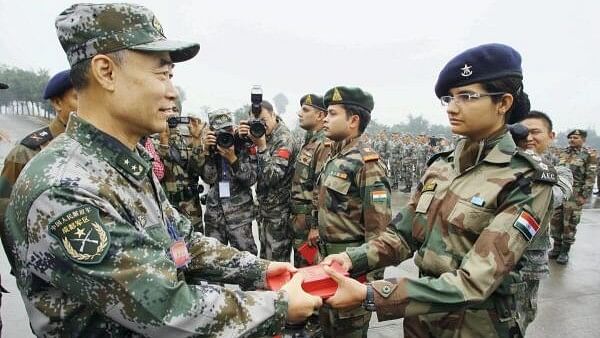
India and China reach agreement on patrolling along LAC
Credit: PTI File Photo
New Delhi: India on Monday announced an agreement with China on the patrolling arrangement along the Line of Actual Control in eastern Ladakh.
The breakthrough in the protracted negotiations between the two sides set the stage for Prime Minister Narendra Modi’s first formal bilateral meeting with President Xi Jinping since the Indian Army and the Chinese People’s Liberation Army got engaged in a stand-off along the de facto boundary between the two nations in eastern Ladakh in April-May 2020. Shortly after Foreign Secretary Vikram Misri announced the latest India-China deal, External Affairs Minister S Jaishankar said that the two nations had gone back to “where the situation was in 2020” and the process of disengagement of troops had been completed.
The deal on the patrolling arrangement along the LAC was announced just a day before Modi’s departure to Kazan in Russia for the 16th BRICS summit, which would commence on Tuesday and conclude on Thursday. He is likely to have a bilateral meeting with Xi on the sideline of the summit.
“Over the last several weeks, Indian and Chinese diplomatic and military negotiators have been in close contact with each other in a variety of forums,” the foreign secretary said while briefing the media persons on the prime minister’s visit to Russia to attend the BRICS summit. “As a result of these discussions, agreement has been arrived at (on) patrolling arrangements along the Line of Actual Control in the India-China border areas, leading to disengagement and a resolution of the issues that had arisen in these areas in 2020.”
“We will be taking the next steps on this,” said Misri, who, however, did not provide the details of the latest agreement between India and China.
A source in New Delhi, however, told DH that India would not immediately lower its guard along the LAC given the trust deficit with China. The Chinese PLA has not pulled out the additional troops it deployed in eastern Ladakh since April-May 2020. The Indian Army too would not withdraw soldiers from the ‘rear areas’, beyond the routine repositioning of frontline troops during winter months. “The disengagement would be followed by de-escalation which could take months,” added the source.
The aggressive moves by the Chinese PLA to unilaterally change the status quo along the LAC in eastern Ladakh and the counter-deployment by the Indian Army in April-May 2020 had started the military stand-off between the two neighbouring nations in eastern Ladakh.
A research paper presented by a police officer based at Leh in Ladakh at a conference of the top cops in New Delhi on January 22, 2023, had noted that India had lost access to 26 – PP 5-17, 24-32, 37, 51, 52 and 62 – of the 65 patrolling points along its LAC with China since April-May 2020, when the stand-off had started.
“We reached an agreement on patrolling and with that the disengagement that we have gone back to where the situation was in 2020 and we can say with that the disengagement process with China has been completed,” Jaishankar said at an event hosted by a TV channel in New Delhi. “I think it is a good development; it is a positive development, and I would say it is a product of very patient and very persevering diplomacy.”
The bilateral relations hit a new low after the stand-off had reached a flashpoint with the violent clash between the soldiers of the Indian Army and the Chinese PLA in Galwan Valley on June 15, 2020. The withdrawal of the Indian Army troops from the scene of the clash to reciprocate to the pull-back by the Chinese PLA as well as the moratorium on patrolling resulted in the creation of a three-kilometer-long (about 1.5 kilometres on both sides) “buffer zone” in Galwan Valley by July 6, 2020.
The Indian Army had earlier regularly sent soldiers from its permanent base at the Dhan Singh Thapa Post near Finger 3 on the northern bank of Pangong Tso lake for patrolling up to Finger 8. But it had to suspend patrolling after a scuffle between its troops and the Chinese PLA soldiers near Finger 4 in May 2020. The PLA had later built bunkers and observation posts and deployed additional troops in the area – thus denying access to the Indian Army to its earlier patrolling limit at Finger 8. The February 2021 deal, however, created an eight-kilometer-long buffer zone between Finger 3 and Finger 8 on India’s side of the LAC with China (on Pangong Tso northern bank), with a moratorium on patrolling by both sides.
Though protracted negotiations led to the mutual withdrawal of troops by both the Indian Army and the Chinese PLA from Gogra Post and Hot Springs in 2022, the stand-off could not be resolved completely.
The PLA troops deployed in Depsang, well inside the territory of India along the LAC with China, are continuing to block the Indian Army’s access to Patrolling Points 10, 11, 12, 12A, and 13. The two sides, however, recently reached closer to a deal for disengagement of troops from the face-off point at Demchok.
“So, what has happened is that we reached an understanding which will allow the patrolling which you spoke about Depsang, that's not the only place,” Jaishankar said in response to a query from the audience. “There are other places also. The understanding to my knowledge is that we will be able to do the patrolling which we were doing in 2020 (before the stand-off started),” he said.
The source in New Delhi told DH that the latest agreement would lead to the resumption of patrolling in all the face-off points, although the limits of the patrolling might not be the same as 2020.
